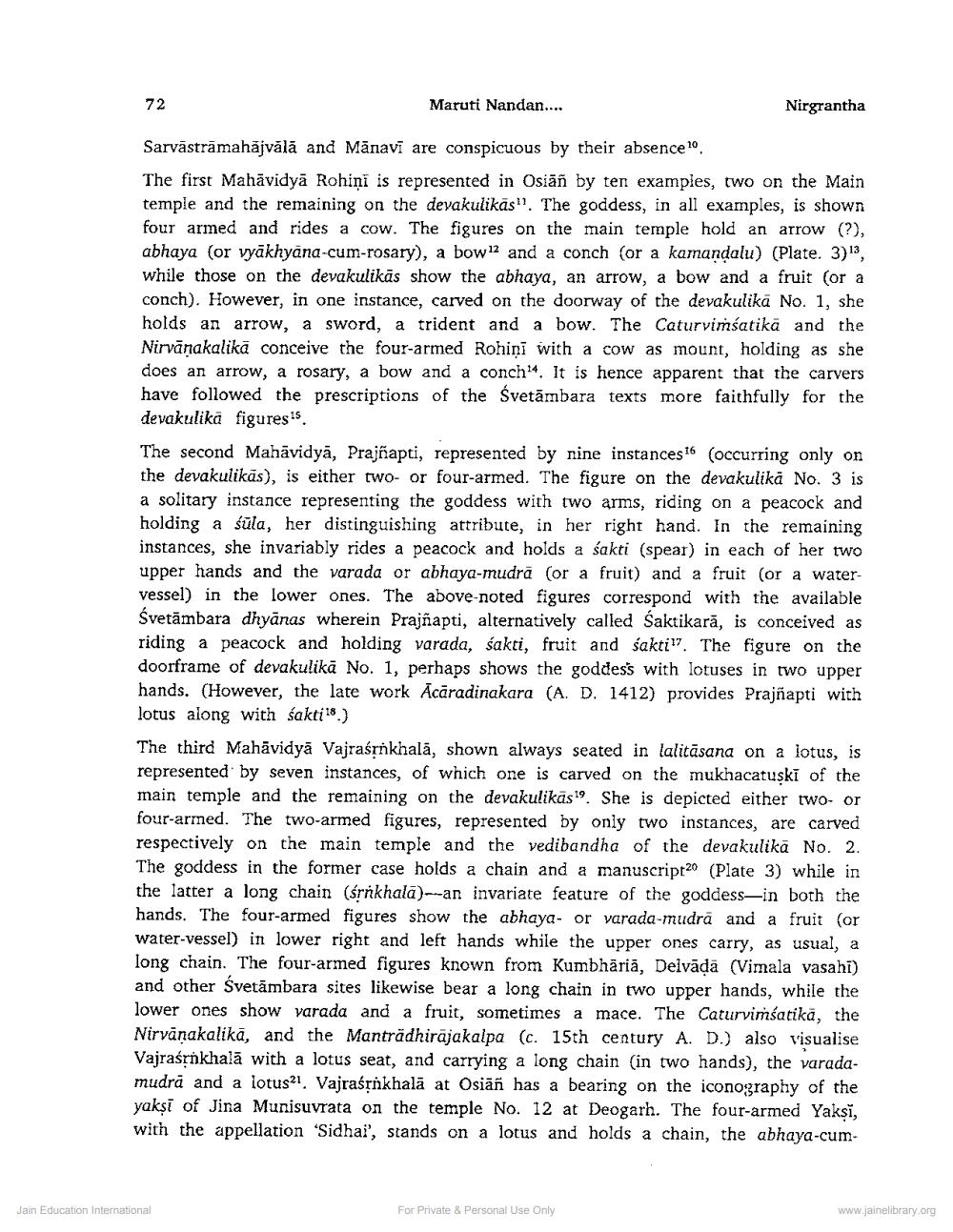Book Title: Jaina Mahavidyas in Osian Author(s): Maruti Nandan Prasad Tiwari, Kamalgiri Publisher: Z_Nirgrantha_1_022701.pdf and Nirgrantha_2_022702.pdf and Nirgrantha_3_022703.pdf View full book textPage 3
________________ 72 Maruti Nandan.... Nirgrantha Sarvāstrāmahājvālā and Mänavī are conspicuous by their absence, The first Mahavidyā Rohiņi is represented in Osiāñ by ten examples, two on the Main temple and the remaining on the devakulikās". The goddess, in all examples, is shown four armed and rides a cow. The figures on the main temple hold an arrow (?), abhaya (or vyākhyana-cum-rosary), a bow 12 and a conch (or a kamandalu) (Plate. 3)'3, while those on the devakulikās show the abhaya, an arrow, a bow and a fruit (or a conch). However, in one instance, carved on the doorway of the devakulikā No. 1, she holds an arrow, a sword, a trident and a bow. The Caturvimśatika and the Nirvanakalikä сonceive the four-armed Rohini with a cow as mount, holding as she does an arrow, a rosary, a bow and a conch. It is hence apparent that the carvers have followed the prescriptions of the Śvetārbara texts more faithfully for the devakulika figures. The second Mahāvidyā, Prajñapti, represented by nine instances 16 (occurring only on the devakulikās), is either two or four-armed. The figure on the devakulika No. 3 is a solitary instance representing the goddess with two arms, riding on a peacock and holding a sūla, her distinguishing attribute, in her right hand. In the remaining instances, she invariably rides a peacock and holds a sakti (spear) in each of her two upper hands and the varada or abhaya-mudra (or a fruit) and a fruit (or a watervessel) in the lower ones. The above-noted figures correspond with the available Śvetāmbara dhyānas wherein Prajñapti, alternatively called Saktikarā, is conceived as riding a peacock and holding varada, sakti, fruit and sakti”? The figure on the doorframe of devakulikā No. 1, perhaps shows the goddess with lotuses in two upper hands. (However, the late work Acaradinakara (A. D. 1412) provides Prajñapti with lotus along with śakti 18.) The third Mahāvidyā Vajraśnkhalā, shown always seated in lalitāsana on a lotus, is represented by seven instances, of which one is carved on the mukhacatuski of the main temple and the remaining on the devakulikās". She is depicted either two- or four-armed. The two-armed figures, represented by only two instances, are carved respectively on the main temple and the vedibandha of the devakulikā No. 2. The goddess in the former case holds a chain and a manuscript20 (Plate 3) while in the latter a long chain (śrnkhalā)-an invariate feature of the goddess in both the hands. The four-armed figures show the abhaya- or varada-mudra and a fruit (or water-vessel) in lower right and left hands while the upper ones carry, as usual, a long chain. The four-armed figures known from Kumbhāriā, Deivādā (Vimala vasahi) and other Śvetāmbara sites likewise bear a long chain in two upper hands, while the lower ones show varada and a fruit, sometimes a mace. The Caturvimsatikā, the Nirvanakalikā, and the Manträdhirajakalpa (c. 15th century A. D.) also visualise Vajraśrnkhalā with a lotus seat, and carrying a long chain (in two hands), the varadamudrā and a lotusal. Vajraśộnkhalā at Osiäñ has a bearing on the iconography of the yakși of Jina Munisuvrata on the temple No. 12 at Deogarh. The four-armed Yaksi, with the appellation 'Sidhai', stands on a lotus and holds a chain, the abhaya-cum Jain Education International For Private & Personal Use Only www.jainelibrary.orgPage Navigation
1 2 3 4 5 6 7 8 9 10 11 12 13 14 15 16 17 18 19 20
